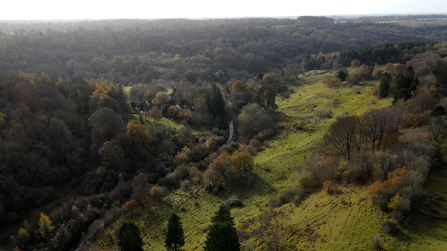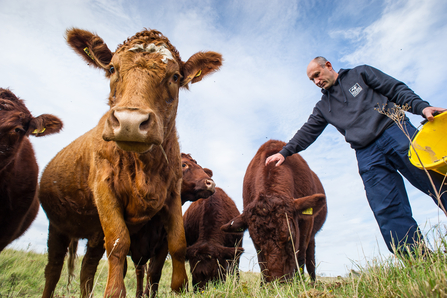One of the things we really need to do is think about the scale we’re operating at – and we need to think bigger. That’s been the thinking underpinning our Estates Review which has involved some tough decisions to refocus our work. We need to think about working with others on nature’s recovery at a scale that even a few years ago would have felt terrifying. But desperate times need ambitious plans.
A ‘Wildbelt’ for the Severn?
River Severn

Daneway Banks
The idea of the Wildbelt
The concept of a Wildbelt has been promoted by the Wildlife Trusts with Government support as a new designation to support nature’s recovery. We’ve got limited (in terms of land area) wild places like Sites of Special Scientific Interest (SSSIs) that protect areas that are already of high value for nature. Other designations like the greenbelt don’t take biodiversity into account. And many of our protected landscapes (like AONBs and National Parks) are currently under-delivering for nature. So what’s not to like about a new designation that’s entirely focused on turning round declines in wildlife?
The idea of a Wildbelt is still being developed, but it would enable land that is currently of low biodiversity value to support nature’s recovery, help join-up high value sites, and speed-up the creation of the Nature Recovery Network that we’ve mapped for the county at GWT. The Wildbelt could also boost nature’s role in solving other challenges, such as flood management, and provide the additional recreational space, which we know from this pandemic is so vital to creating sustainable, healthy communities.
At GWT, we are really interested in exploring what the concept of a Wildbelt at scale might look like – and so we’ve been working with other Wildlife Trusts up the Severn to explore the idea. From the estuary through to the source in the Plynlimon Hills, could we work alongside farmers and landowners to imagine a vast belt of connected woodlands and wetlands that people could enjoy and where wildlife can thrive? We want to involve farmers in the area from the start to identify new ways to deliver more for nature as part of a successful farm business.

Farmer and cattle - Matthew Roberts
Luckily, we’re not alone – and others are coming up with similar ambitions for the Severn. The Environment Agency has just launched a new River Severn Partnership to make the whole River Severn catchment the most vibrant and resilient in the UK – with an outstanding natural environment.
Why the Severn?
But why focus on the Severn, when other areas in the county could benefit from the Wildbelt concept too? The landscapes of the Severn catchment form one of the most important ‘eco-regions’ in the UK. This area is particularly vulnerable to the impacts of climate change, affecting both wildlife and people. So, there’s a real opportunity for new projects in the area to deliver multiple benefits and build the resilience of wildlife, communities and businesses to climate change.
So, what might the Severn Wildbelt include? Well as a starter for ten it could include re-naturalisation of the main river, letting nature help us manage the impact of climate change, while at the same time creating amazing new floodplains for wildlife that also improve our resilience to flooding. It could mean storing carbon through woodland and wetland creation at scale. We’ve got a project we’ve been planning that would connect the Forest of Dean and the Wyre Forest that would sit perfectly under the Wildbelt banner.
We could also use the idea to extend public access, engaging with communities and providing new infrastructure to support health and wellbeing through a planned and connected network of wild places. There’s already some interest in a ‘Severn Vale Regional Park’ between Gloucester and Tewkesbury. And perhaps we could also use the Wildbelt concept to explore the reintroduction of keystone and critically endangered species that would help us restore broken ecosystems, building on existing projects with pine marten and eel. Beavers are also a fantastic keystone species that can help to restore healthy wetlands. The Government announced that beavers would be allowed to spread from current populations in the South West. There may be an opportunity to establish a population within the Wildbelt or support farmers and landowners to get beaver ready.
Beaver - David Parkyn/ Cornwall Wildlife Trust
The Severn Wildbelt also provides a wider context for some existing projects and helps to improve collaboration on wildlife initiatives across the area. The Cotswold Canals Connected project we are involved in is a good example, creating new wetland habitats alongside the new stretch of the canal being restored between Stonehouse and the Severn. How much more powerful to think about this project in the context of connected wetlands stretching up the Severn floodplain. That’s also true further up the Severn, where we’ve been talking with the landowner at Elmore Court on his ambitious rewilding plans.
What will GWT do next?
With other Wildlife Trusts up the Severn, we want to play a central role in developing the Severn Wildbelt concept, but developing the vision needs to be shared. One of the purposes of the Wildbelt is to encourage communities and partners to develop and deliver their own projects. Anything on this scale will need to be based on partnership, including crucially with the farmers, landowners and communities who live in the area.
This really does feel like an important moment to double down and think with much more ambition about nature’s recovery in our county. I completely acknowledge that an idea on this scale could be unwieldy, but it’s time to think big. Whether it ends up being called a Wildbelt or something else isn’t the issue. What matters is that we have a proper crack at restoring one of the most important and vulnerable landscapes for wildlife in the country.

Wye Valley

